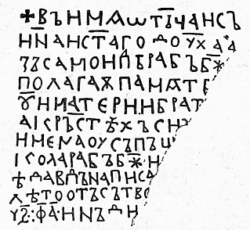| Samuil's inscription | |
|---|---|
 A 19th-century photograph of the original tombstone. The inscription is in the lower right angle | |
| Material | Marble |
| Writing | Old Slavonic |
| Created | 992/3 CE |
| Discovered | Agios Germanos (now West Macedonia, Greece) |
| Present location | National Historical Museum, Bulgaria |
| Culture | First Bulgarian Empire |
Samuil's Inscription is a medieval text that was found on the tombstone of Samuel of Bulgaria's parents, erected in 992/3 CE. One of the oldest preserved Cyrillic Slavic inscriptions, [1] [2] it was made in the First Bulgarian Empire by the order of Tsar Samuel. The text mentions the names of Samuel's parents as well as of his brother David.
Contents
The inscription was discovered in 1888 in the village of German, near Lake Prespa, now Greece, during the construction of the new church of the village. [3] [4] In 1916, it was taken by Bulgarian occupation authorities to Bulgaria, where it is currently stored at the National Historical Museum in Sofia. Its original location is thought to have been in the town of Prespa on the island of St. Achilles, from where it was subsequently transferred to the old church of German, which dates back to 1006. The dimensions of the tombstone are 125–130 cm high, 52–67 cm wide, and 7–10 cm thick. The inscription has been cited by historians such as Fyodor Uspensky, Yordan Ivanov, and Nicholas Adontz.

